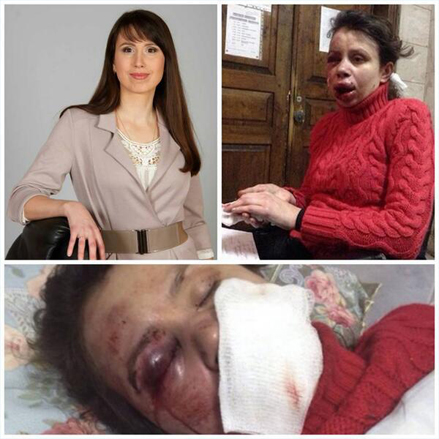Improving Your Life Through Immigration Since 1974
Articles
This page contains articles I have written on immigration-related themes and other articles of interest
Home > Information Bank > Articles
Symbols Define Revolutions: Regime Change in Ukraine
by Mark Semotiuk
Sometimes ordinary people become symbols of revolutions. Often this happens as if by chance. For example, no one could have predicted the impact of Nelson Mandela’s 27 year prison sentence. The stories that follow are of people who defined the meaning of their respective struggles.

Articles Published By Others
Mohammed Bouazizi was a 26 year old Tunisian man who dreamed of a better life. His father passed away when he was three. By the time he was 10 he was the breadwinner for his family of eight. For seven years he spent his days pushing around a cart selling vegetables. He dreamed of one day owning a truck to make his work easier.
On December 17th 2011, Bouazizi’s unlicensed vegetable cart – his entire business capital -was confiscated by a police officer. The officer reportedly slapped Bouazizi, spit in his face and insulted his dead father. Humiliated, he went to the provincial headquarters hoping to complain. Officials of the dictatorial regime refused to see him. Later that day, Bouazizi poured fuel over himself and set himself on fire.
Bouazizi’s self-immolation symbolized that Tunisians had been stripped of their rights by a dictatorship. To obtain their sovereignty the regime would have to fall.
Bouazizi’s story sent shockwaves throughout the Middle East and North Africa. Within 10 days of his death, the 23 year rule of Tunisia’s dictator, Ben Ali, was over. Within a year, Mubarak stepped down in Egypt, Gaddafi was killed in Libya, and a civil war began in Syria. Bouazizi’s act defined the Jasmin Revolution, and several repressive governments fell.
ORANGE REVOLUTION
Natalyia Dmytruk was a Ukrainian woman born to deaf parents. As a result of this she made sign language her vocation. Over the years she earned a job as a sign language interpreter for Ukraine’s state-run television channel. Daily, she appeared in a little box at the bottom of television screens communicating to the hearing-impaired community.
On November 25th, 2004, Dmytruk showed up as usual for the 11am broadcast. Ukraine held its presidential election just days before. Although election monitors reported wide spread vote rigging by the state-supported candidate, Dmytruk was told to report the elections were legitimate.
Unwilling to validate the state’s propaganda she staged a silent protest. She signed: ”I am addressing everybody who is deaf in Ukraine. . . . Do not trust the results of the central election committee. They are all lies. . . . I am very ashamed to translate such lies to you. Maybe you will see me again." The last sentence hinted of her awareness that the state may violently punish her for her act of defiance. Dmytruk’s defiance personified that people were no longer willing to accept the government’s lies. For democratic legitimacy, new elections would have to be held.
Partially as a result of her actions, tens of thousands of people poured into the streets of Kyiv. The protests were eventually successful when Ukraine’s Supreme Court ordered a reelection. Election monitors subsequently declared these new elections as “free and fair.” Dmytruk’s acts defined the revolution for the people of Ukraine, and Ukrainians won free and fair elections.
EUROMAIDAN
Tatyana Chornovol is a reporter and mother of two in Ukraine. Recently, she rose to some prominence due to her investigative reports on the murky business affairs and conspicuous wealth of Ukraine’s top officials. Chornovol was a speaker at Euromaidan, the epicenter of Ukraine’s current mega-protests. In her speeches Chornovol indicated that she knew her acts of defiance may result in violence towards her by the government.
On Christmas Day, 2013, Chornovol was returning home when her car was repeatedly rammed by a Porsche Cayenne. A dramatic YouTube video shows how she tried to escape from danger in her car but was eventually run off the road. Three men brutally beat her and left her unconscious in a ditch. She was placed in intensive care, and her recovery will require multiple surgeries.
From the beginning, the Euromaidan protests focused on the President’s last minute turn away from a long negotiated European Union Association Agreement. They grew after the riot police beatings of journalists and non-violent demonstrators on November 30th and December 11th, 2013. Chornovol’s beating was one of at least 40 incidents against reporters. With these systematic beatings of journalists and non-violent demonstrators the true meaning of these protests crystalized. Chornovol’s beatings symbolize the government’s shift from legitimacy to tyranny.
The Chonovol incident shows that the government either used force against its citizens or failed to protect its citizens. Once a sovereign fails to systematically uphold the rule of law, the people are no longer obligated to obey. They have both the right and the obligation to defend themselves from violence.
The stories of these three individuals defined the meanings of their respective struggles. Bouazizi’s self-immolation symbolized that Tunisians had been stripped of their freedom by a dictatorship. To obtain their sovereignty the regime would have to fall. Dmytruk’s defiance personified that people were no longer willing to accept the government’s lies. For democratic legitimacy, new elections would have to be held. Chornovol’s beatings symbolize the government’s shift from legitimacy to tyranny. Ukrainians are no longer safe, and therefore, the current government must fall.
Mark Semotiuk is a Fordham University Law Student currently studying European Union Law in Paris at Pantheon-Assas (Paris II). Mr. Semotiuk has been an international election observer in Ukraine on multiple occasions. He can be reached at andy@myworkvisa.com.

Articles Published By Others
Mohammed Bouazizi was a 26 year old Tunisian man who dreamed of a better life. His father passed away when he was three. By the time he was 10 he was the breadwinner for his family of eight. For seven years he spent his days pushing around a cart selling vegetables. He dreamed of one day owning a truck to make his work easier.
On December 17th 2011, Bouazizi’s unlicensed vegetable cart – his entire business capital -was confiscated by a police officer. The officer reportedly slapped Bouazizi, spit in his face and insulted his dead father. Humiliated, he went to the provincial headquarters hoping to complain. Officials of the dictatorial regime refused to see him. Later that day, Bouazizi poured fuel over himself and set himself on fire.
Bouazizi’s self-immolation symbolized that Tunisians had been stripped of their rights by a dictatorship. To obtain their sovereignty the regime would have to fall.
Bouazizi’s story sent shockwaves throughout the Middle East and North Africa. Within 10 days of his death, the 23 year rule of Tunisia’s dictator, Ben Ali, was over. Within a year, Mubarak stepped down in Egypt, Gaddafi was killed in Libya, and a civil war began in Syria. Bouazizi’s act defined the Jasmin Revolution, and several repressive governments fell.
ORANGE REVOLUTION
Natalyia Dmytruk was a Ukrainian woman born to deaf parents. As a result of this she made sign language her vocation. Over the years she earned a job as a sign language interpreter for Ukraine’s state-run television channel. Daily, she appeared in a little box at the bottom of television screens communicating to the hearing-impaired community.
On November 25th, 2004, Dmytruk showed up as usual for the 11am broadcast. Ukraine held its presidential election just days before. Although election monitors reported wide spread vote rigging by the state-supported candidate, Dmytruk was told to report the elections were legitimate.
Unwilling to validate the state’s propaganda she staged a silent protest. She signed: ”I am addressing everybody who is deaf in Ukraine. . . . Do not trust the results of the central election committee. They are all lies. . . . I am very ashamed to translate such lies to you. Maybe you will see me again." The last sentence hinted of her awareness that the state may violently punish her for her act of defiance. Dmytruk’s defiance personified that people were no longer willing to accept the government’s lies. For democratic legitimacy, new elections would have to be held.
Partially as a result of her actions, tens of thousands of people poured into the streets of Kyiv. The protests were eventually successful when Ukraine’s Supreme Court ordered a reelection. Election monitors subsequently declared these new elections as “free and fair.” Dmytruk’s acts defined the revolution for the people of Ukraine, and Ukrainians won free and fair elections.
EUROMAIDAN
Tatyana Chornovol is a reporter and mother of two in Ukraine. Recently, she rose to some prominence due to her investigative reports on the murky business affairs and conspicuous wealth of Ukraine’s top officials. Chornovol was a speaker at Euromaidan, the epicenter of Ukraine’s current mega-protests. In her speeches Chornovol indicated that she knew her acts of defiance may result in violence towards her by the government.
On Christmas Day, 2013, Chornovol was returning home when her car was repeatedly rammed by a Porsche Cayenne. A dramatic YouTube video shows how she tried to escape from danger in her car but was eventually run off the road. Three men brutally beat her and left her unconscious in a ditch. She was placed in intensive care, and her recovery will require multiple surgeries.
From the beginning, the Euromaidan protests focused on the President’s last minute turn away from a long negotiated European Union Association Agreement. They grew after the riot police beatings of journalists and non-violent demonstrators on November 30th and December 11th, 2013. Chornovol’s beating was one of at least 40 incidents against reporters. With these systematic beatings of journalists and non-violent demonstrators the true meaning of these protests crystalized. Chornovol’s beatings symbolize the government’s shift from legitimacy to tyranny.
The Chonovol incident shows that the government either used force against its citizens or failed to protect its citizens. Once a sovereign fails to systematically uphold the rule of law, the people are no longer obligated to obey. They have both the right and the obligation to defend themselves from violence.
The stories of these three individuals defined the meanings of their respective struggles. Bouazizi’s self-immolation symbolized that Tunisians had been stripped of their freedom by a dictatorship. To obtain their sovereignty the regime would have to fall. Dmytruk’s defiance personified that people were no longer willing to accept the government’s lies. For democratic legitimacy, new elections would have to be held. Chornovol’s beatings symbolize the government’s shift from legitimacy to tyranny. Ukrainians are no longer safe, and therefore, the current government must fall.
Mark Semotiuk is a Fordham University Law Student currently studying European Union Law in Paris at Pantheon-Assas (Paris II). Mr. Semotiuk has been an international election observer in Ukraine on multiple occasions. He can be reached at andy@myworkvisa.com.






